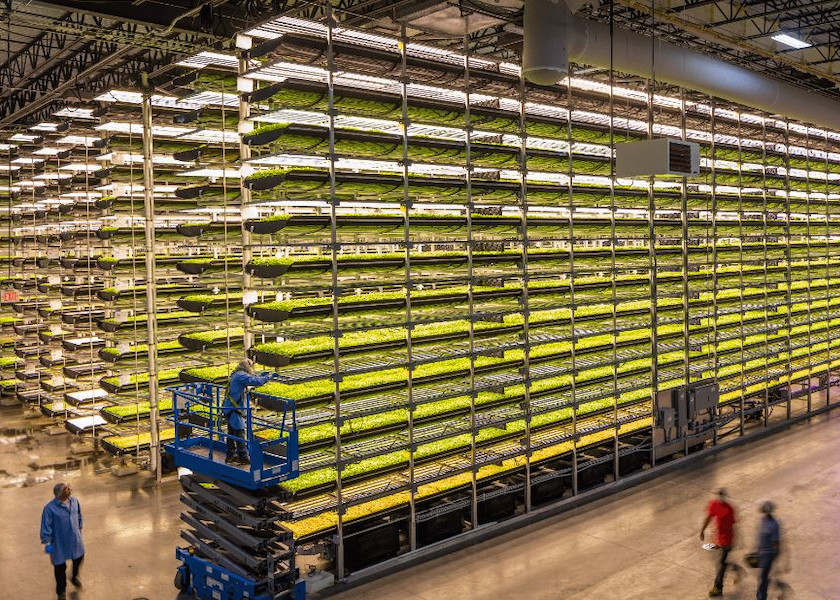CEA Food Safety Coalition changes name, expands focus

After more than a decade of exponential growth, the controlled environment agriculture sector of the produce industry is taking more concrete shape to define itself.
The Washington, D.C.-based CEA Food Safety Coalition, founded in 2019 to develop industrywide food safety standards for indoor leafy greens growers, is expanding its mission to serve the broader needs of all controlled-environment food growers, according to a news release.
Learn more: Controlled Environment Agriculture
“With a new name and mission, the new Controlled Environment Agriculture Alliance — ‘CEA Alliance’ — will expand its membership to serve growers delivering the freshest, best-tasting and most nutritious fruits and vegetables to consumers, with the least environmental impact; reducing use of water, land and other scarce resources; and employing the most rigorous practices to ensure the safety of our products,” CEA Alliance Executive Director Tom Stenzel said in the release.
Members include a wide variety of both indoor vertical farms and greenhouse growers. The board of directors of the CEA Alliance includes:
- Marc Oshima, co-founder and chief marketing officer of AeroFarms
- Katie Seawell, chief commercial officer of Bowery Farming
- Tim Cunniff, co-founder and executive vice president of sales at Little Leaf Farms
- Todd Linsky of Superior Fresh/TLC
- Dinesh Babu, vice president of food safety and compliance at Revol Greens
- Matt Lingard, vice president for agriculture and science of Bright Farms
- Dan Malech, senior vice president of strategy and general counsel at Plenty
The CEA Alliance will continue its support of unique food safety standards for indoor-grown produce, but it will expand its portfolio of services to include public policy advocacy; support for sustainability and climate-smart agriculture; and support of retail and foodservice companies in delivering differentiated produce to consumers.
Controlled environment growers use a variety of agricultural production methods and technology to create optimal growing conditions, including indoor vertical farms and glass greenhouses with rigorous environmental controls. Technologies include hydroponics, aeroponics, aquaponics and soil-based systems to grow specialty crops.
Controlled environment produce is a distinct and rapidly growing category, evidenced by the expansion of these companies with more farm locations, placement in more retail locations, taking up more real estate in supermarkets’ refrigerated salad shelves, and more capital investments. Some traditional field-grown farming companies are also diversifying by adding CEA divisions to supplement the business.
These CEA companies often tout similar benefits, they say, including:
- Growing year-round brings consumers consistency and reliability, with a supply chain unaffected by climate change and erratic weather conditions.
- Controlled environment produce has environmental benefits, including reduced use of water, land and other scarce natural resources. Indoor growers use fewer or no pesticides, reduce food waste and reduce carbon emissions from long-distance transportation by locating farms closer to markets.
- Controlled environment farming creates stable agriculture jobs that are year-round, pay good wages and offer a safe and comfortable working environment. CEA growers support both urban and rural communities, often bringing good jobs to economically challenged communities.
- By eliminating seasonality and variability, increasing domestic production, bringing food production closer to the end consumer, and producing more outputs with fewer inputs, controlled environment farming will reduce the impact on the food system from climate events, supply shocks, geopolitical events, droughts and other unknown events.
The CEA Alliance will work to establish consistent metrics for measuring and communicating these key benefits, in collaboration with stakeholders and in compliance with existing recognized global standards, according to the release. These metrics will be measurable, transparent and verifiable, allowing companies to communicate credibly with consumers and other stakeholders about operations.
“Transparency with our customers and end consumers is an important part of our culture,” Stenzel said in the release. “CEA growers aspire to be the fresh produce of choice for consumers, while working with traditional outdoor growers to increase fruit and vegetable consumption,” Stenzel said.
While produce industry companies are competing with one another, there’s also a spirit of teamwork for the greater purpose of boosting fresh-produce consumption and public health overall, however it’s grown.
“Consumers worldwide need to increase their consumption of fruits and vegetables for health, and CEA-grown produce will be an important ally of conventional agriculture in delivering that solution,” Stenzel said.
The CEA Alliance previously worked with a retail advisory committee, but it will now add a new membership category for retail and foodservice companies, now joining with CEA growers and the growers’ business service providers, government and academic researchers as key participants in the membership association.
The CEA Alliance recently supported the National Association of State Departments of Agriculture in adopting a policy position in support of investment in CEA agriculture, according to the release. The association will host its first federal public policy meeting in February 2023 in Washington, D.C. to brief policymakers about opportunities in the 2023 Farm Bill and future legislation to support consumers through controlled environment agriculture.
To learn more, contact Tom Stenzel, executive director of CEA Alliance, at tom@ceafoodsafety.org.
Related news:
- Video and article: The Whole Foods Market deal with this indoor, vertical farm brand
- 'Tip of the Iceberg' podcast, video, story: Where CEA is headed, says Bowery Farming's Katie Seawell
- Fair Food Program certifies its first vertical farm, Hardee Fresh
- Driscoll's heads to Virginia to grow strawberries in world's largest indoor vertical farm







